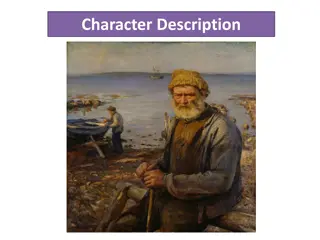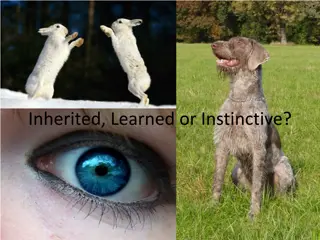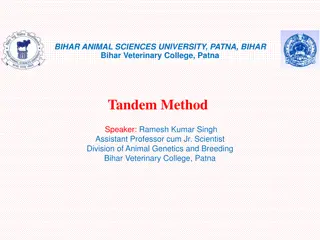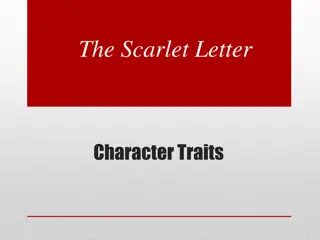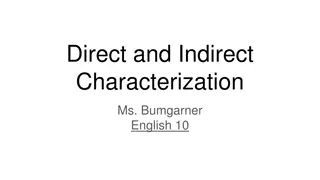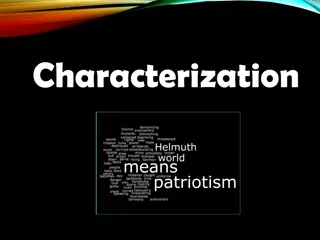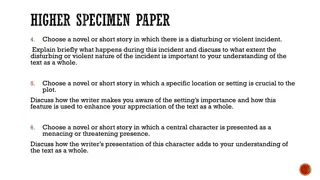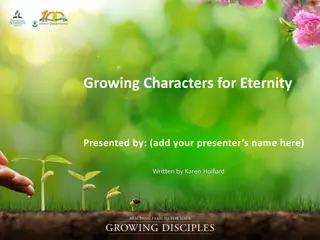Understanding Character Traits and Types in Literature
Character traits in literature help define and understand characters, with internal qualities shaping external behaviors. Authors can teach readers about characters through actions, descriptions, speech, interactions, and judgments. Characters can be round (dynamic) or flat (static), and the protagonist and antagonist play key roles. Archetypes provide universal symbols in storytelling.
Download Presentation

Please find below an Image/Link to download the presentation.
The content on the website is provided AS IS for your information and personal use only. It may not be sold, licensed, or shared on other websites without obtaining consent from the author. Download presentation by click this link. If you encounter any issues during the download, it is possible that the publisher has removed the file from their server.
E N D
Presentation Transcript
Trait: a quality of mind or habit of behavior Ex: self centered; sloppy; needy Character traits help us to define and understand a character Internal quality (ex. Selfishness) determines external behavior
5 ways in which an author can teach you about the characters 1. Actions by characters reveal their nature What we do defines who we are 2. Author s descriptions of characters Appearance & Environment can reveal socioeconomic status 3. What the character says Speeches move plot along but also allow us to draw conclusions about character s motives
4. What others say about the character Listen to what other characters say and what it reveals about a given character 5. The author (as narrator) presents judgments about the character Usually doesn t happen in fiction most apt to happen in a play
Round (usually the hero) Round characters undergo some sort of change, making them DYNAMIC characters Author presents enough detail to make them full, lifelike, and memorable Change may be shown in Actions Realization of new strength Acceptance of new conditions or the need to make changes The discovery of unrecognized truth
Flat Flat characters do not grow or change; they stay the same, making them STATIC characters Usually act to highlight the changes of the dynamic characters Stock Characters: representatives of a class or group stereotypes! Insensitive father, interfering mother; greedy politician
Protagonist: a round character, who is clearly the main character in a story, but who lacks the qualities of a hero. Antagonist: someone or something that opposes the goals of the protagonist (the bad guy) Archetype: theoriginal patternormodelfrom which allthings of thesame kind are copied or on whichthey are based;amodeloruniversal symbol; prototype (the hero, the mother figure, the villain, the scapegoat, etc.-can also be theme)
H He er ri it ta ag ge e Protagonist Antagonist Dee/ Wangero Mother and Maggie Honesty and Integrity Self posturing / artificiality Self-Sacrifice Rapacity aesthetisism utilitarianism Authentic relationship to a heritage of things made for everyday use Ethnic Pretentiousness
Everyday Use Ingrained habits may be given up if justice makes a greater demand. or A person whose honesty and tolerance have long made her susceptible to the strong will of another may reach a point where she will exert her own will for the sake of justice.
Cathedral (1983) Raymond Carver
Raymond Carver (1938-1988) Influential short story writer of the last decades of the 20th century; influence comparable to Hemingway s in the earlier part of the century Born in Clatskanie, Oregon, raised in Pacific Northwest, married girlfriend right after high school (divorced in 1982) Blue-color background: worked as janitor, sawmill worker (like his father); he often wrote about lower middle class workers Struggled with alcoholism, like his father; quit drinking in 1977
Raymond Carver (1938-1988) got college degree and received M.F.A. from prestigious University of Iowa Writers Workshop (from which Flannery O Connor had graduated) Taught at several universities, including Syracuse University in New York Married poet Tess Gallagher in 1988; died that year of lung cancer
Raymond Carver (1938-1988) His style has been called minimalist for its simple, spare narration; Carver rejected the term because it smacks of smallness of vision and execution. Some early stories are bleak but later ones, like Cathedral, developed a more positive, spiritual dimension
Vision vs. Reality Cathedral is about vision vs. reality in several senses Vision of cathedrals vs. narrator s drab reality (job, married life) Vision achieved in spite of real blindness Television (mass-media) vs. real life Art (drawing) vs. real life/ T.V.
Narrators Reality Marriage: My wife finally took her eyes off the blind man and looked at me. I had the feeling she didn t like what she saw. I shrugged (177); My wife and I hardly ever went to bed at the same time (180) Job: How long had I been in my present position? (Three years.) Did I like my work? (I didn t.) Was I going to stay with it? (What were the options?) (178)
Chartres Cathedral of Notre-Dame
Chartres Cathedral of Notre-Dame
Cathedrals: Narrators Description (2) They re massive. They re built of stone. Marble, too, sometimes. In those olden days, when they built cathedrals, men wanted to be close to God. In those olden days, God was an important part of everyone s life. You could tell this from their cathedral-building (181).
Carvers Style Simple, direct Colloquial- language is casual and conversational: it's the difference between "What are you going to do?" and "Whatchagonnado?" Statements of what happens, how things work (176, last ): I saw my wife laughing as she parked the car. . . . Carver shows the minute details of reality to help us to see Similar to the narrator and his wife helping the blind man see the details of the cathedral, the face
Direct Characterization Author/narrator makes clear statements about the character s personality and what the character is like Examples of Carver s direct characterization of Robert This blind man was late forties a heavy-set balding man with stooped shoulders, as if he carried a great weight there Find 3 other examples of Direct Characterization with your table group.
Indirect Characterization the writer reveals information about a character and his personality through that character's thoughts, words, and actions, along with how other characters respond to that character, including what they think and say about him. Think of it this way direct characterization is a tell , while indirect characterization is a show Find 3examples of Indirect Characterization of with your table group. Consider: Why does the narrator s wife want Robert to visit? What factors lead to that decision? How do we know how Robert feels? How does the author hint at Robert s mental state throughout the story?
Direct characterization moves plot along more quickly Indirect characterization engages the reader s imagination more WRITING: First, determine what you deem to be Robert s major character trait the one that really defines who he is. Then, discuss which method of characterization is more effective in Cathedral . Write out a one paragraph explanation of which method of characterization is more effective to determine the major character trait. Be specific. You must include at least two direct quotes from the story to support your opinion



